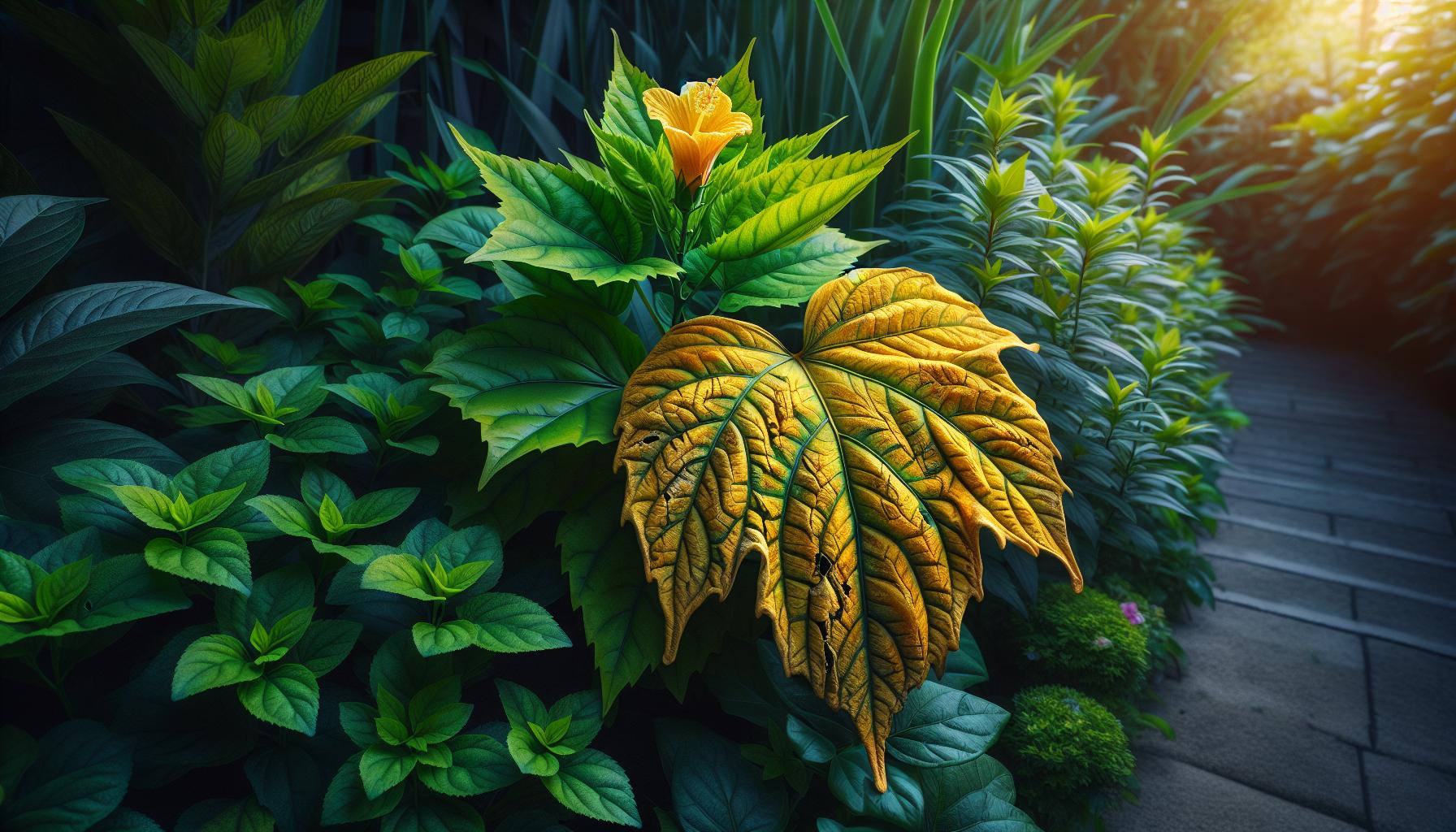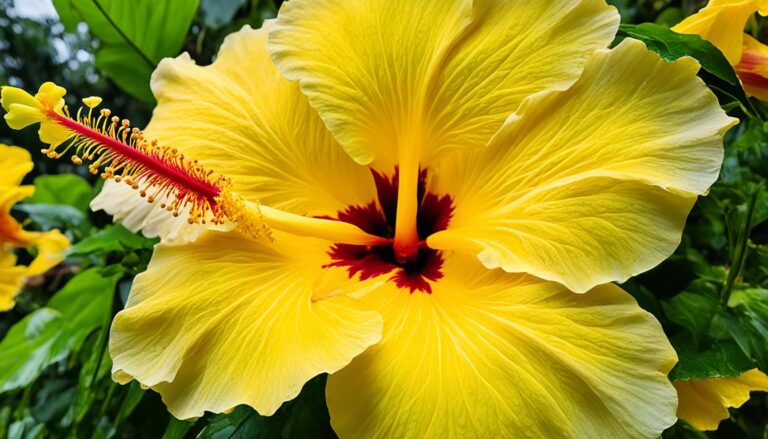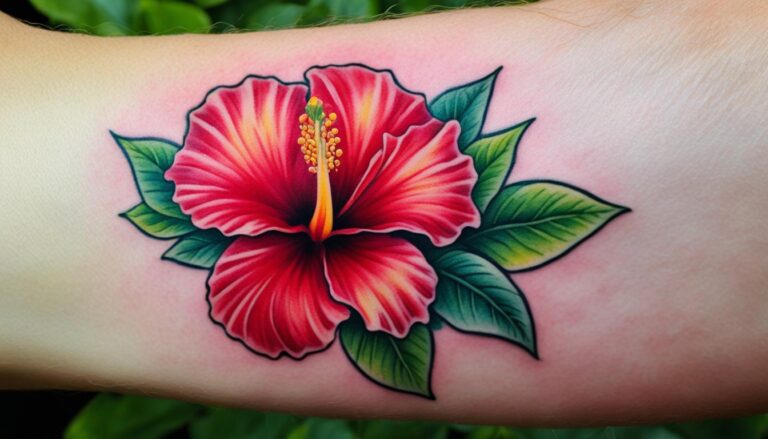Stop Yellowing Hibiscus Leaves: Causes, Diagnosis & Fixes
When we notice our hibiscus leaves turning yellow, it’s a clear signal that something’s amiss. As avid gardeners, we understand how disheartening it can be to see such vibrant plants struggle. Yellowing leaves are more than just an aesthetic issue; they’re a cry for help, signaling potential problems ranging from nutrient deficiencies to pest invasions.
In our journey to maintain lush, blooming hibiscus plants, we’ve gathered some key insights into why this yellowing occurs and how to address it. Identifying the root cause is the first step in restoring the health and beauty of these tropical beauties. Join us as we explore effective strategies to prevent and treat yellowing hibiscus leaves, ensuring our gardens remain a source of pride and joy.
Key Takeaways
- Yellowing hibiscus leaves signal underlying issues like nutrient deficiencies, watering problems, pest infestations, or environmental stress, requiring immediate attention to prevent plant decline.
- Key signs of yellowing include a pale hue on leaves, brittleness, and premature dropping, often accompanied by stunted growth or deformation, which necessitates thorough plant inspection.
- Addressing the root causes of yellowing involves proper watering practices, correcting nutrient imbalances with soil testing and fertilization, managing pests through regular inspection and treatment, and ensuring optimal growth conditions regarding light, temperature, and soil quality.
- Preventive care, including regular monitoring for pests, maintaining soil quality and moisture levels, balanced nutrient application, and proper pruning, is essential for healthy, vibrant hibiscus plants.
- Creating an optimal growing environment, tailored to hibiscus preferences for sunlight, warmth, and well-draining soil, significantly reduces the risk of yellowing leaves and promotes flourishing plants.
Understanding Yellowing Hibiscus Leaves
After discussing the noteworthy concern of hibiscus leaves turning yellow and the implications it carries for the health and beauty of the plants, it’s crucial to delve further into understanding this phenomenon. Recognizing the signs and understanding why it’s a significant concern are vital steps in addressing the issue effectively.
The Signs to Look For
Identifying yellowing leaves in hibiscus plants involves more than just noting a change in color. We observe several key indicators that signal trouble. Initially, the leaves may exhibit a pale yellow hue, which can gradually cover the entire leaf or manifest in spots. Additionally, yellow leaves often become more brittle and may drop prematurely. In some cases, other symptoms accompany the yellowing, such as stunted growth or deformed new leaves, indicating the problem’s severity. It’s imperative to inspect the plant thoroughly, including the underside of leaves and the stem, for pests which frequently contribute to yellowing.
Why It’s a Concern
Yellowing leaves on a hibiscus plant are not just an aesthetic issue; they’re a distress signal from the plant. This condition, often a manifestation of stress, can be caused by factors such as poor soil composition, inadequate watering (either too much or too little), nutrient deficiencies, or pest infestations. Each of these issues can severely impact the plant’s ability to perform photosynthesis, a critical process for plant health and growth. Without addressing the underlying cause, yellowing leaves can lead to a decline in plant vigor, reduced flowering, and, if left unchecked, the death of the plant. Understanding why yellowing occurs enables us to take corrective action, ensuring our hibiscus plants remain healthy, vibrant, and a source of delight in our gardens.
Common Causes of Yellowing Leaves

In the context of gardening, recognizing the common causes of yellowing leaves, especially in hibiscus plants, is critical. We explore the various factors that may contribute to this issue, ranging from nutrient deficiencies to environmental stress, and provide insights into how each factor plays a role in impacting plant health.
Nutrient Deficiencies
Nutrient deficiencies stand as a primary culprit behind the yellowing of hibiscus leaves. Hibiscus plants demand a balanced supply of nutrients, including nitrogen, iron, and magnesium for optimal growth and leaf coloration. If the soil lacks these essential nutrients, leaves begin to yellow as a sign of deficiency. For example, nitrogen deficiency typically manifests as yellowing in older leaves first, as nitrogen is mobilized to new growth. Conversely, iron deficiency often causes yellowing between the veins of young leaves. Addressing nutrient deficiencies involves testing the soil and applying the appropriate fertilizers to restore nutrient balance.
Watering Issues
Watering issues, encompassing both underwatering and overwatering, significantly influence leaf coloration. Hibiscus plants prefer consistently moist soil; however, they cannot tolerate standing water or completely dry conditions for prolonged periods. Overwatering leads to root rot and oxygen starvation, while underwatering stresses the plant, causing leaves to yellow and drop prematurely. We recommend establishing a regular watering schedule, adjusting based on seasonal changes, to maintain adequate soil moisture levels without over-saturating the soil.
Pest Infestations
Pest infestations by insects such as aphids, spider mites, and whiteflies pose a threat to hibiscus leaves, resulting in yellowing and other damage. These pests feed on the sap of the leaves, causing them to turn yellow and, in severe cases, to drop off the plant. Regular inspection of the hibiscus plants for signs of pests and timely intervention with appropriate insecticides or natural predators can help manage infestations and preserve plant health.
Environmental Stress
Environmental stress, including extreme temperatures, inadequate light, and strong winds, can trigger yellowing leaves in hibiscus plants. Hibiscus plants thrive in warm environments with plenty of sunlight. Exposure to direct afternoon sunlight in extreme temperatures may lead to sunscald, causing leaves to yellow and wilt. Similarly, insufficient light results in yellowing and weak growth as the plant struggles to photosynthesize efficiently. Shielding plants from extreme conditions, ensuring adequate light, and providing windbreaks can mitigate environmental stress, promoting healthy growth and vibrant foliage.
Diagnosing the Problem

When hibiscus leaves start turning yellow, it’s crucial to accurately diagnose the problem to apply the correct remedy. Understanding the cause behind this common issue involves a close examination of both the leaf patterns and the plant’s environment. By identifying the specific stressors affecting the plant, we can take targeted actions to alleviate the problem and promote the health and vibrancy of hibiscus plants.
Examining Leaf Patterns
Observing the patterns on the leaves provides us with significant clues about the underlying issues. Different symptoms can indicate various problems:
- Uniform yellowing across multiple leaves often points to a nutrient deficiency, such as a lack of nitrogen or iron. These deficiencies can hinder the plant’s ability to synthesize chlorophyll, the green pigment responsible for photosynthesis.
- Yellowing with green veins suggests an iron deficiency specifically, also known as chlorosis. This condition prevents leaves from producing sufficient chlorophyll.
- Spots or splotches of yellow often indicate a pest problem. Aphids, whiteflies, and spider mites suck sap from the leaves, disrupting the flow of nutrients and water, which leads to discoloration.
- Yellow leaves with brown edges or spots can signal overwatering or underwatering. Both conditions stress the plant by either drowning the roots or not providing enough moisture for proper growth.
Recognizing these patterns helps us pinpoint the cause of the yellowing leaves and apply the appropriate treatment more effectively.
Assessing Plant Environment
The environment in which a hibiscus plant grows plays a significant role in its health. Assessing the plant’s surroundings helps us identify environmental stress factors that could contribute to leaf yellowing:
- Lighting conditions: Hibiscus plants thrive in bright, indirect light. Too much direct sunlight can scorch the leaves, while too little light can weaken the plant’s overall health.
- Temperature and humidity: Extreme temperatures, whether too hot or too cold, can stress the plant and cause yellowing leaves. Hibiscus plants prefer a warm, humid environment similar to their tropical origin.
- Soil quality and drainage: Poor soil quality or improper drainage can lead to root rot or nutrient deficiencies. Ensuring the soil is rich and well-draining helps maintain healthy roots and facilitates the appropriate uptake of nutrients.
- Watering frequency and volume: Overwatering can suffocate plant roots, while underwatering can leave them too dry. Both conditions can lead to stress and yellowing leaves. Regular, moderate watering that keeps the soil moist but not waterlogged is ideal.
By closely examining the environmental conditions and making necessary adjustments, we can create an optimal growing environment and address issues contributing to the yellowing of hibiscus leaves. Through a careful diagnostic process that includes assessing both leaf patterns and plant environment, we facilitate healthier, more resilient hibiscus plants.
Solutions to Reverse Yellowing

Adjusting Watering Techniques
Understanding the watering needs of a hibiscus plant is crucial to prevent yellowing leaves. We’ve gathered that both overwatering and underwatering can lead to stress, manifesting as yellow leaves. To mitigate this, we ensure the soil around our hibiscus is moist but not waterlogged. We recommend using a well-draining soil mix and checking the top inch of soil for dryness before watering again. During hot weather, hibiscus plants may need more frequent watering, while in cooler temperatures, less is often more. Implementing a consistent watering schedule, adjusted for seasonal changes, helps us maintain healthy hydration levels for our hibiscus plants.
Fertilizing Correctly
Nutrient deficiencies are a common cause of yellowing leaves in hibiscus plants. To address this, we ensure our hibiscus receives the right balance of nutrients. A balanced, slow-release fertilizer, rich in potassium and iron, is ideal for promoting vibrant foliage and flowers. We apply fertilizer according to the product instructions, typically at the beginning of the growing season and then every few months as needed. Avoiding over-fertilization is key, as excessive nutrients can harm the plant. By providing the right nutrients, we help our hibiscus plants thrive and prevent yellow leaves from nutrient deficiencies.
Managing Pests and Diseases
Pests and diseases can also cause the leaves of the hibiscus to turn yellow. We tackle this challenge by regularly inspecting our plants for signs of infestation or illness. Common pests affecting hibiscus include aphids, spider mites, and whiteflies. If we spot any, we use an appropriate insecticidal soap or neem oil treatment, following the product’s directions carefully. For diseases such as fungal infections, removing affected leaves and improving air circulation around the plant can be effective prevention methods. By staying vigilant and managing pests and diseases promptly, we protect our hibiscus from the stressors that lead to yellowing leaves.
Creating an Ideal Growing Environment
Ensuring a hibiscus plant is in its ideal growing environment is fundamental to preventing yellow leaves. We pay close attention to light, temperature, and soil conditions. Hibiscus plants flourish in full sunlight and require at least 6 hours of direct sunlight daily. We place our plants in spots where they can receive ample light, adjusting their location with the seasons if necessary. Temperature-wise, hibiscus prefers warmer climates and should be protected from cold drafts or frost. We use a well-draining soil mix to promote healthy root growth and prevent waterlogging. By creating and maintaining an optimal growing environment, we greatly reduce the risk of our hibiscus plants developing yellow leaves.
Preventive Measures for Healthy Hibiscus

After addressing the causes and solutions for yellowing hibiscus leaves, focusing on preventive measures is crucial for maintaining vibrant and healthy plants. Proper care routines and practices can prevent stress factors that lead to yellowing.
Regular Monitoring and Care
Monitoring hibiscus plants regularly forms the cornerstone of preventive care. By keeping a close eye, we can detect early signs of stress, whether from pests, nutrient deficiencies, or improper watering. Here’s how we achieve effective monitoring and care:
- Check for Pests: Inspect the leaves and stems at least once a week for signs of pests. Early detection allows for prompt intervention, preventing damage and spread.
- Watering Practices: Ensure consistent watering, allowing the soil to dry slightly between waterings. Overwatering or under-watering can lead to stress and yellow leaves.
- Soil Quality: Test the soil periodically to ensure it’s well-draining and contains the right balance of nutrients. Amend the soil with organic matter to improve its texture and fertility.
- Nutrient Balance: Apply a balanced fertilizer formulated for hibiscus plants every few weeks during the growing season. Avoid over-fertilizing, as this can cause more harm than good.
The Role of Proper Pruning
Pruning is not just about shaping the plant; it plays a significant role in maintaining hibiscus health. Proper pruning techniques help in several ways:
- Removal of Dead or Diseased Parts: Regularly remove dead, diseased, or yellowing leaves and branches. This action prevents the spread of disease and redirects the plant’s energy to healthy growth.
- Improving Air Flow: By thinning out dense areas, we improve air circulation within the plant. Better air flow reduces the risk of fungal diseases that can cause yellowing leaves.
- Stimulating Growth: Pruning can stimulate new growth, leading to a fuller, more vibrant plant. It’s vital, however, to prune at the right time—ideally, at the end of the dormant period before new growth starts.
Incorporating these preventive measures into our routine care ensures that our hibiscus plants remain healthy, reducing the likelihood of yellowing leaves. By practicing regular monitoring and care, alongside proper pruning, we create an ideal environment that promotes the growth of strong, resilient hibiscus plants.
Conclusion
We’ve walked through the journey of understanding why hibiscus leaves turn yellow and how to address this common issue. It’s clear that keeping these vibrant plants healthy requires attention to detail and a proactive approach. By diagnosing the specific cause of yellowing, whether it’s nutrient deficiencies, pests, or environmental stress, we can apply targeted solutions. Adjusting our watering techniques, ensuring the soil has the right nutrients, and creating an ideal environment are key steps toward revitalizing our hibiscus plants. Remember, prevention is always better than cure. Regular monitoring, proper watering, and maintaining soil quality will go a long way in preventing issues before they start. Let’s put these practices into action and enjoy the beauty of lush, green, and blooming hibiscus plants in our gardens.







